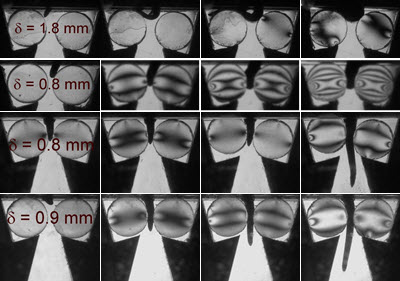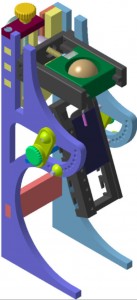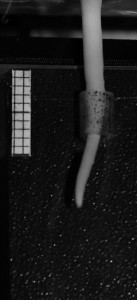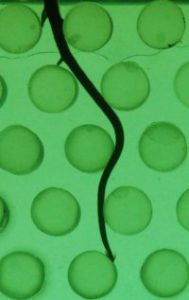Plant or tree roots adapt their morphology according to the mechanical and topological properties of the soil. Depending on the soil density or confining pressure, on the size and connectivity of pores between solid constituents of the soil, the root will be blocked or grow further, either by curving and avoiding obstacles or by pushing the grains. As soil strength increases, it is usually observed that root elongation rate decreases and that the root thickens radially instead of elongating longitudinally. Therefore the competing effects of soil mechanical impedance and penetrating capacities of the plant lead to different strategies for root development, which in turn modifies differently the soil physical properties (soil constituent organization, repartition of water, local packing fraction…etc). It is therefore of primary importance to design in a first step simple conceptual experiments to understand progressively the intricate soil/root system from a mechanical point of view. Thus we designed experiments of root growth inside modelled granular soils and focused on the simple geometry of roots entering a constriction between grains.
2D constriction:
First experiments have already been performed on a single root system inside a model soil constituted of only two fixed discs separated by a well defined gap. In the 2D setup, the root is a radicle at its first stage of development (no secondary root) and is constrained to grow through the pore formed between the grains along a main vertical direction. The originality of the technique we developed is that the grains are photoelastic discs, i.e. optically birefringent when submitted to a deviatoric mechanical stress. During its development, the root exerts a radial pressure on its sides, thus creating an evolving pattern of optical fringes in the neighbouring photoelastic grains. By taking successive pictures with the use of a CCD camera, it is possible to measure simultaneously and in situ the forces exerted by the root as well as its associated morphological changes.
 Chick-pea (Cicer arietinum L.) root growth inside the setup. We observe the evolution of the length and diameter of the root while growing inside the gap between the two photoelastic discs placed between circular polarizers. The evolution of the black fringe pattern is a way to measure the force exerted by the root during its growth. The different pictures are obtained from left to right, at 45 min after the experiment launching, 5.5 hours after, 10.25 hours after. The minimum gap between discs is 1 mm.
Chick-pea (Cicer arietinum L.) root growth inside the setup. We observe the evolution of the length and diameter of the root while growing inside the gap between the two photoelastic discs placed between circular polarizers. The evolution of the black fringe pattern is a way to measure the force exerted by the root during its growth. The different pictures are obtained from left to right, at 45 min after the experiment launching, 5.5 hours after, 10.25 hours after. The minimum gap between discs is 1 mm.
Depending on the gap width compared with the root diameter and on the initial root’s angle, different scenarii of growth are possible.
Chick Pea Growth in between photoelastic diks
3D constriction:
The former 2D constriction between two photoelastic discs has been replaced by an elastomeric tube of adjustable rigidity and geometry. The elasticity of the tube mimics the possibility for a root to enlarge the pore in which it grows and to push the surrounding grains in a granular and reorganisable soil.
Mechanics of root:
 We have tested the evolution of the mechanical properties of a root with its water content. Root is drying in air or in mannitol baths at various osmotic pressures. The Young’s modulus of the root is tested in bending experiments or in compression or traction with an INSTRON machine.
We have tested the evolution of the mechanical properties of a root with its water content. Root is drying in air or in mannitol baths at various osmotic pressures. The Young’s modulus of the root is tested in bending experiments or in compression or traction with an INSTRON machine.
Assembly of posts:
Arrays of cylindrical obstacles are used to trigger the reorientation of root growth.




